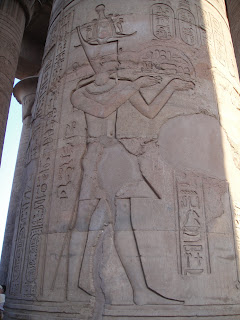Despite the loud night, which saw the “budget” Gap Tour patrons actively (and loudly) talking and partying on the “support” boat until the wee hours of the morning, we woke up very early on the felucca boat – before 6 am – and were transferred onto the support boat where we had eaten our meals yesterday. We had breakfast, and set off down the Nile to the rendezvous point with our bus. This took us from the west side of the Nile, the so-called “darkness” to the “light,” or the east side of the Nile, and our tour guide Kalid pointed this out as we set sail.
 |
| A beautiful morning on the Nile. We woke up just as the sun was rising! |
The Egyptians have historically believed that life comes from the sun, and that the sun rising and setting is a somewhat-spiritual event. Thus, where the sun rises, the east, is seen as the place of “life” or “light.” This affects a lot of things in Egypt, but most obviously, it actually affects property values and everything that stems from that. Wealthier Egyptians want to live in the east of the Nile, and this makes it cheaper to live on the west side. The Nubian people of Egypt have traditionally had less money (and power) and so we find the majority of the Nubian villages on the west side of the river.
Kom Ombo stands impressively nearly right on the bank of the Nile, and the tour boats that trawl up and down the Nile stopped right outside its gates. As we wandered the temple, admiring the very ornate carvings left by the Ptolemaic dynasty, we saw a few Nile-boat tourists who weren’t even bothering to get off their boats to check out the temple – preferring to examine it in bathing suits through binoculars.
After leaving Kom Ombo, we took the bus to the town of Edfu, home of the aptly-named “Edfu Temple.” Outside of the pyramids, we thought that Edfu was the largest temple – and ancient artifact – we had seen in Egypt to this point. Edfu was especially impressive due to the large amount of surviving paint within the temple, and we thought its “Bird” motif was especially notable – but not surprising, as Edfu was also dedicated to the falcon god Horus.
Edfu had been buried under the sand, as had most of the monuments we have visited throughout Egypt. This sand preserved the bulk of the monuments, but in many instances also washed away the paint and some of the stone carvings in the process. Also, in Edfu, we saw many instances of intentional defacement – first by the Christians, and later by the occupying Muslims. Most faces were chipped away, as were arms and feet – any semblance of a human or “god” body was defaced by which ever religion was in power, and viewed the ancient temples as a threat.
 |
| The view as you enter the Edfu Temple - it was enormous! |
 |
| Tabitha poses for a picture in front of some of the ancient Edfu Temple ruins. |
 |
| The second entrance to the Temple - this one was protected from birds with large screens between the columns. Ironic, since the temple was constructed to worship the bird god Horus. |
 |
| The very innermost sanctuary of the temple, replete with a ceremonial boat. |
 |
| Erin and James sitting in front of one of the Horus monuments in front of the Temple. |
We finished Edfu, and completed our trip to Luxor, another city on the east bank of the Nile. We checked into our hotel, the Hotel Susanna, and while James organized the room, Erin headed out into town with some of our group members to pick up some lunch: Egyptian falafel (fried chickpea patties with vegetables in flatbread) and shawarma (shaved chicken with vegetables in a roll). After shaking the dust from our feet, we set out to explore Luxor, first walking through the Luxor markets, starting with the tourist market and extending into the local shops and street-side vendors. From there, we walked along the Nile admiring the many Nile cruise ships, and we finished our walk with a trip through downtown Luxor, where we were the only tourists in sight. After a quick dinner and some time on-line, we settled in early, anticipating a 4am wake-up call the next day.
 |
| Luxor Temple, which was nearly across the street from our hotel! |
 |
| The obelisk and monuments in front of the temple were very dramatic. |
 |
| A campaign advertisement. Signs like these were on many of the larger intersections. |
 |
| The Winter Palace Hotel - a 5-star hotel along the Nile...a bit nicer than ours! |
















